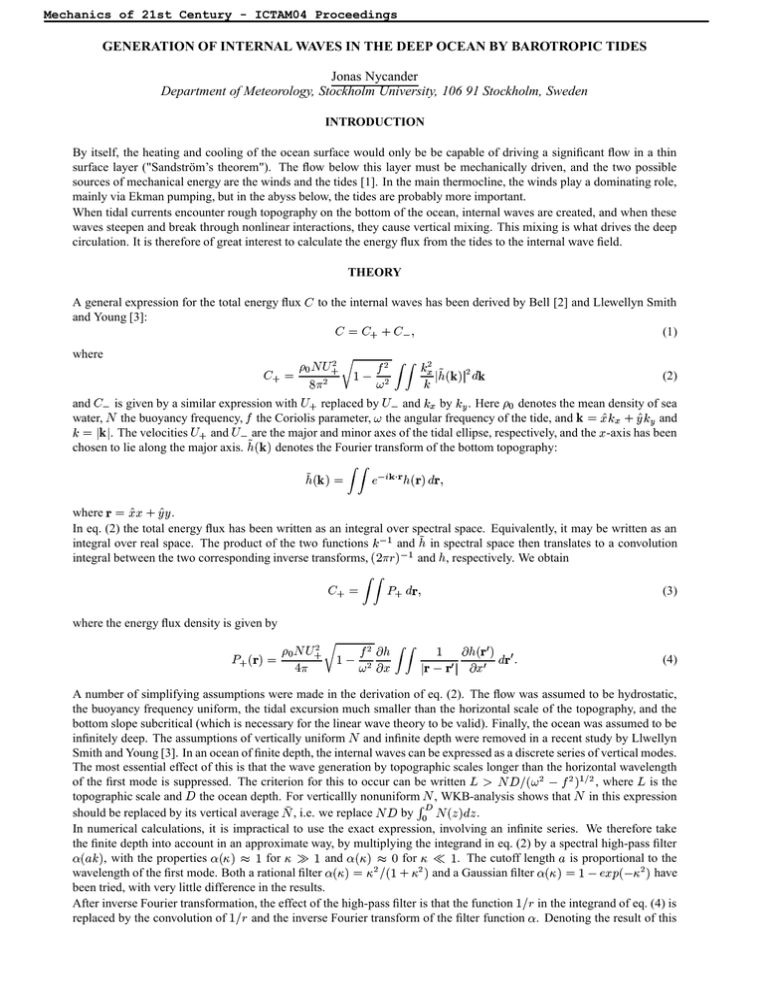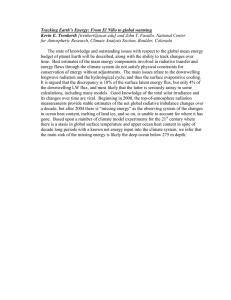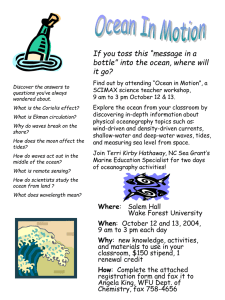GENERATION OF INTERNAL WAVES IN THE DEEP OCEAN BY BAROTROPIC... Jonas Nycander Department of Meteorology, Stockholm University, 106 91 Stockholm, Sweden
advertisement

Mechanics of 21st Century - ICTAM04 Proceedings GENERATION OF INTERNAL WAVES IN THE DEEP OCEAN BY BAROTROPIC TIDES Jonas Nycander Department of Meteorology, Stockholm University, 106 91 Stockholm, Sweden INTRODUCTION By itself, the heating and cooling of the ocean surface would only be be capable of driving a significant flow in a thin surface layer ("Sandström’s theorem"). The flow below this layer must be mechanically driven, and the two possible sources of mechanical energy are the winds and the tides [1]. In the main thermocline, the winds play a dominating role, mainly via Ekman pumping, but in the abyss below, the tides are probably more important. When tidal currents encounter rough topography on the bottom of the ocean, internal waves are created, and when these waves steepen and break through nonlinear interactions, they cause vertical mixing. This mixing is what drives the deep circulation. It is therefore of great interest to calculate the energy flux from the tides to the internal wave field. THEORY A general expression for the total energy flux and Young [3]: to the internal waves has been derived by Bell [2] and Llewellyn Smith (1) where ' *,) +.-,/ 10 ! (2) # $ " & " % is given by a similar expression replaced by and %' ( by ( . Here denotes the mean density of sea with and - 56 4 ' 78 4 and water, the buoyancy frequency, the Coriolis parameter, ! the angular frequency of the tide, and % 3 % 2 - . The velocities and *9 are the major and minor axes of the tidal ellipse, respectively, and the 6 -axis % has%2 been ) : + , / chosen % ( ( to lie along the major axis. denotes the Fourier transform of the bottom topography: >=@?BA C *9+:DE/ D *,) +.-,/ 0 "$"<; D F6G4 6 78B4 8 . where H spectral In eq. (2) the total energy flux has been written as an integralIover space. Equivalently, it may be written as an *) in spectral I H integral over real space. The product of the two functions and space then translates to a convolution +KJ ML / and * , respectively. integral between the two corresponding inverse transforms, % We obtain 0D (3) "N"O where the energy flux density is given by *9+:D U / R * DVU U 0 D UXW +.D/ PQ 6 D (4) ! O S "T" S 6 S A number of simplifying assumptions were made in the derivation of( eq. (2). ( SThe flow was assumed to be hydrostatic, the buoyancy frequency uniform, the tidal excursion much smaller than the horizontal scale of the topography, and the bottom slope subcritical (which is necessary for the linear wave theory to be valid). Finally, the ocean was assumed to be infinitely deep. The assumptions of vertically uniform and infinite depth were removed in a recent study by Llwellyn Smith and Young [3]. In an ocean of finite depth, the internal waves can be expressed as a discrete series of vertical modes. The most essential effect of this is that the wave generation by topographic scales longer than the horizontal wavelength of the first mode is suppressed. The criterion for this to occur can be written , where is the topographic scale and the ocean depth. For verticallly nonuniform , WKB-analysis shows that in this expression should be replaced by its vertical average , i.e. we replace by . In numerical calculations, it is impractical to use the exact expression, involving an infinite series. We therefore take the finite depth into account in an approximate way, by multiplying the integrand in eq. (2) by a spectral high-pass filter , with the properties for and for . The cutoff length is proportional to the wavelength of the first mode. Both a rational filter and a Gaussian filter have been tried, with very little difference in the results. in the integrand of eq. (4) is After inverse Fourier transformation, the effect of the high-pass filter is that the function replaced by the convolution of and the inverse Fourier transform of the filter function . Denoting the result of this [ g +:h / % +g Xij/lk L ] a b [ ni m g +Ki>/okqp g +Ki>/ i ] + ce d isr i/ / H`_ + ! YZ \[^] Y +XfB/ 0 f h +g Ki>/ 63t + i / ; L ]g Mechanics of 21st Century - ICTAM04 Proceedings Figure 1. Logarithm of the energy flux density in W/m from the M2 tide to internal waves in the Brazil Basin (e.g. -3 means 10 W/m ). + L / , the resulting final expression for the flux density is +:D/ Q ! 6* + D D U / *96+:D U U / 0 D U (5) O S "$" S + L / approximately L L r h , while S ( S where is the buoyancy frequency at the bottom. The function equal to ] for + L / L for L m h . For the rational and Gaussian filter functions used( ishere, can be expressed analytically in terms h of integrals of Bessel functions. The cutoff length is defined by h Pa [ ! where is a numerical coefficient of order unity that is determined with an analytically solvable test frombytheby comparison problem with a simple ridge topography. The contribution minor tidal component is given by a similar U O 8 U , respectively. expression as eq. (5), with , 6 and 6 replaced by , 8 and convolution O O O RESULTS +L / O is calculated numerically from eq. (5) and the corresponding equation for . In The energy flux density order to evaluate in one point, one must integrate over a region around this point. Since decreases rapidly beyond the cutoff length , the integral was truncated at a distance from the evaluation point. For the real ocean, is typically a few tens of kilometers or less. Over this length scale, , and can be considered horizontally uniform, as assumed in the derivation of eq. (2). (This issue would be more problematic if a calculation in spectral space were attempted.) The input data used in the calculations were the Smith and Sandwell bottom topography with a nominal resolution of 1/30 degrees, the Egbert tidal velocities, and the buoyancy frequency obtained from the SAC hydrographic database. Calculations for the global ocean are underway, but have not yet been completed. Results for the Brazil Basin are shown in Fig. 1. The calculated total energy flux for the M2 tide over the area shown is approximately 26 GW. The main uncertainty is due to unresolved topography. It can been seen from other calculations with an additional low-pass filter that most of the energy flux is generated by topographic scales below 10 km, and it therefore seems very likely that a larger energy flux would be obtained with a higher topographic resolution. Another uncertainty is the effect of supercritical slope. For the area shown in the figure, the total energy flux from points where the slope is supercritical (and the theory therefore unvalid) is approximately 12 GW. hO h h References [1] Munk W.H., Wunsch C.I.: Abyssal recipes. II: Energetics of tidal and wind mixing. Deep-Sea Res. 45: 1977-2010, 1998. [2] Bell T.H.: Lee waves in stratified flows with simple harmonic time dependence. J. Fluid Mech. 67:705–722, 1975. [3] Lewellyn Smith S.G., Young W.R.: Conversion of the barotropic tide. J. Phys. Oceanogr. 32:1554–1566, 2002. << session << start





